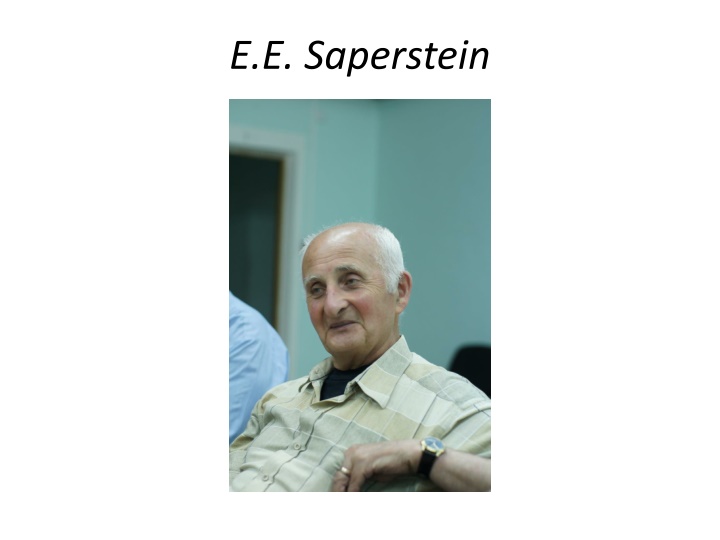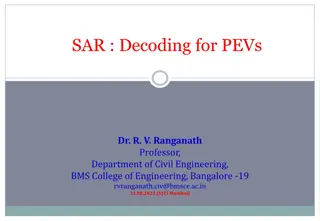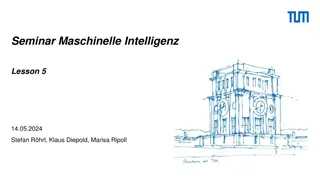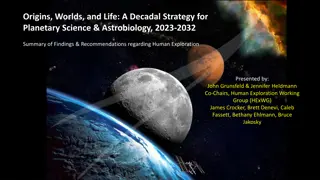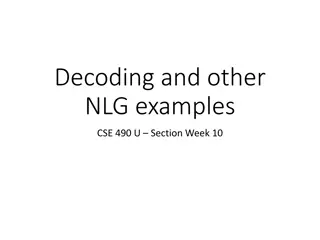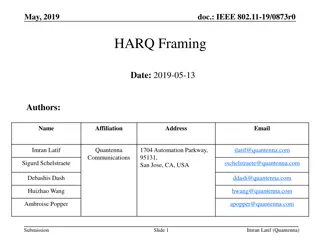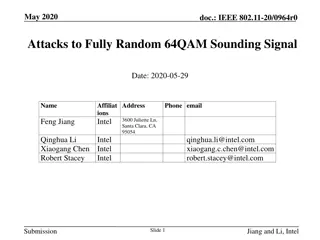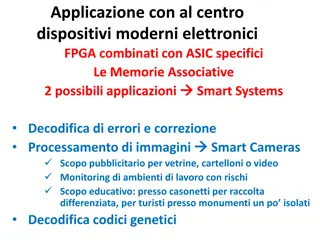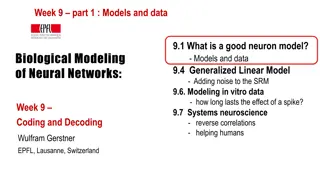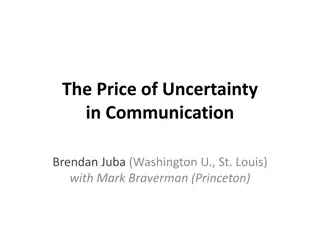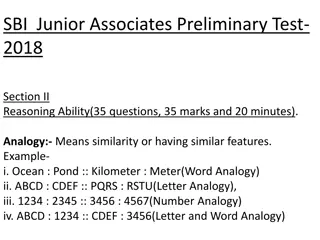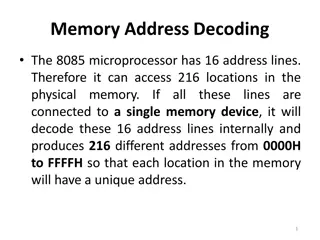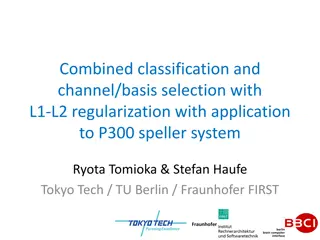Decoding E.E.Saperstein - An Intriguing Exploration
Delve into the enigmatic world of E.E.Saperstein through this immersive exploration. Uncover the depths of his unique perspectives and unravel the mysteries hidden within his works. Join us on a journey of discovery as we analyze, interpret, and appreciate the brilliance encapsulated in the writings of E.E.Saperstein.
Download Presentation

Please find below an Image/Link to download the presentation.
The content on the website is provided AS IS for your information and personal use only. It may not be sold, licensed, or shared on other websites without obtaining consent from the author.If you encounter any issues during the download, it is possible that the publisher has removed the file from their server.
You are allowed to download the files provided on this website for personal or commercial use, subject to the condition that they are used lawfully. All files are the property of their respective owners.
The content on the website is provided AS IS for your information and personal use only. It may not be sold, licensed, or shared on other websites without obtaining consent from the author.
E N D
Presentation Transcript
IAEA REFERENCE DATABASE FOR BETA-DELAYED NEUTRON EMISSION EVALUATION I.N.Borzov National Research Centre Kurchatov Institute , Moscow, Russia Bogolubov Laboratory of Theoretical Physics Joint Institute of Nuclear Research, Dubna, Russia The Fayans functional : Fully self-consistent description of the isospin excitations. Beta decays. Global calculations in very neutron-rich nuclei. INFINUM, BLTP JINR, DUBNA 20 22 MARCH 2019
OUTLINE Theory Fayans EDF Fully self-consistent description of isospin excitations in neutron-rich nuclei. (g.s) and (exc. s.) from one and the same EDF Spin-isospin excitations. Fayans EDF (g.s) / Approximation: (LM) + + (exc. s) Applications Isobaric Analog Resonances in long isotopic chains. Gamow-Teller (GT) and first-forbidden (FF) decays. Global calculations of beta decay half-lives T1/2.
Three main families of phenomenological EDF DF3 -a, -b, -f , FANDF0 Fayans and collaborators, KI ,Moscow since ~1995 BCPM - Barcelona Catania Paris Madrid ( originating from an early work by Baldo et al. ) SeaLL - Seattle Livermore . add corrective terms to account for finite-size and quantum effects and Coulomb potential and pairing corrections. Fayans and SeaLL functionals : the Kohn-Sham type EDF independent-particle kinetic energy , m*=1 directly parametrize the nuclear EoS by series of powers of the density ; 2017 - Recently estabilished new Fayans functional Fy (r)
Self-Consistent Ground State. Fayans EDF. dependent denominator of Fayans EDF Skyrme EDF 1. E( ) mimics -dependence of Hq in qp-L theory; V. Khodel, E. Saperstein Phys. Reports 92 183 (1982) It implicitly accounts for energy dependence of qp-L; m=m*. 2. Kohn-Sham type of EDF Recent development DF3a + deformed HFBTHO : S.V. Tolokonnikov, I.N. Borzov, M. Kortelainen, Yu.S. Lutostansky, E.E.Saperstein J. Phys.G 35, 291, 2014.
Volume and surface energy densities: Pade approximants s(r) similar Pade-like structure + finite range + density gradient terms accounting for many-body interaction and correlations effects) Such complicated dependence of interaction energy on real density E int [ ( r ) ] could hardly appear as an anzats. It had been founded in the qp-Lagrangian theory V. Khodel, E. Saperstein Phys. Reports 92 183 (1982)
Pairing energy density Making the surface and pairing terms dependent on density gradients, the Fayans functional offers the superb simultaneous description of odd- even staggering effects in energies and charge radii. P.-G. Reinhard, W. Nazarewicz Phys.Rev. C95 (2017) Volume and surface energy densities Recently estabilished new Fayans functional Fy (r)
IAS. GT and FF. Fully self-consistent calculation. Self-consistent g.s.calculation GT and FF. Effective NN-interaction. U: Particle-hole channel: -interaction with Landau-Migdal constant g + -meson + -meson exchange 1 (r1, s1, t1). V: Particle-particle channel: T=0, -interaction with one parameter: g pp Neglecting the spin-isospin dependent components in E0 causes ~ 100 KeV error in masses J. Maurgeron (EP J 2010)
Continuum pnQRPA. Full ph-basis, SO(8) symmetry F F F F 1 2 V e V ( ) ( ) ( ) ( ) L M N N 0 q F F F F ^ [ h ( ( 2 1 0 V ( ) ( ) ( ) ( ) M L N N = ] I ) 1 ( d F F F F K 1 2 0 ( ) ) ( ) ) N N K M ) 2 ( d F F F F 2 1 0 ( ) ( ) ( ) ( ) N N M ( ) ( ) = + p n * , ; , ; L r r A r r L A ~~ * pn pn n p SO(8) Self-consistent pnQRPA B.L. Birbrair Nucl. Phys. A108, 449 (1968) SO(4) Standard beta decay Tables P. Moeller et al., Phys. Rev. (1996, 2003, 2012)
IAR. Fully self-consistent approach. H.Liang, Nguen Van Giai, J. Meng Phys.Rev.Lett. 101 (2008). EIAR and EA-IAS are related to neutron skin Rnp X. Roca-Maza et al., Phys.Rev. C 94 (2018) The IAR is calculated based on the same EDF as the one used for masses, charge radii etc. N.I. Pyatov, S.A. Fayans PEPAN 14(4), 953 (1983). V.A. Rodin, M.G. Urin., Phys.Atomic Nuclei 66, 2128 (2003). G.V. Kolomiytsev, M.L. Gorelik, M.G. Urin, Eur. Phys. J. 54, 228(2018).
IAR check of self-consistentcy. IAS degeneracy is broken on the mean field (HF+BCS) level. It should be restored in self-consistent DF+QRPA. CVC small width (in nuclear scale) Including the S=0, T=1 g.s. and dynamical pairing is crucial for full consistency. In this case the strengths has been fairly collected in a single peak . (Artificial width is included just for convenience ) Doubly -non-magic Cd and semi-magic Pb isotopes . I.N.B., S.V. Tolokonnikov, Phys. At. Nucl. (in print, 2019)
DF3-f 1. self-consistent RMF-like 2-body spin-orbit; 2. screening of Coulomb exchange term Exchange Coulomb screening. If one sets Vc exc=0 it removes the Nolen-Shiffer anomaly h Coul A. Bulgac, V.R. Shaginyan, Nucl.Phys.A601, 103 (1996). DF3-f : IAS description in 208Pb and binding energy difference in mirror nuclei demands from ~ 50~% to ~ 80% reduction of Vc_exch
IAR energies in reference Ca, Sn,Pb isochains. , 20 DF3-f functional Without V_Coul_exch : Overall deviation: |Eth | is ~ 200KeV Eth/Eexp ~ < 1 % 18 Pb Ca Sn 16 14 12 10 cf. SAMi Underestimate of E(IAR) E= - 200 900 KeV Eth/Eexp ~ < 5% Up to ~ 10 times larger 8 6 40 50 110 120 130 190 200 210 A DF3-f I.N.B., S.V. Tolokonnikov Phys. At. Nucl . (2019). SAMi : X.Roca-Maza et.al. PRC 94 (2018).
IAR energy in the reference 208 Pb nucleus. V_exch =0 E(IAS) exp =18.862 (0.2) MeV Rch_exp=5.5010(9)fm DF3-f DF3-f Rch_theor=5.5040 fm |Delta Rch/Rexp|=0.05 % E_theor E exp= minus 82 KeV Delta E/Eexp= minus 0.4 % cf. SAMi => 0.2 % cf. SAMi => minus 1 % 4.8 % DF3-f I.N.B., S.V. Tolokonnikov, Phys. At. Nucl. (in print, 2019) S.A. Fayans JETP. Lett 68, 169 (1998); Nucl.Phys. A676, 49 (2000) SAMi X.Roca-Maza et.al. PRL 102 (2018) - ISB, PRC 94 (2018) Coulomb exch.
IAEA REFERENCE DATABASE FOR BETA-DELAYED NEUTRON EMISSION EVALUATION NUCLEAR DATA SHEETS (2019, IN PRESS) Comparison of self-consistent global approaches DF3 - spherical , full basis, GT+FF quasi-spherical nuclei; I.N.Borzov, PRC 67 (2003) DF + Continuum QRPA (2003) DF : Quality of the ground state description: quasi-particle energies and Q , Sxn values. DF3 Account for g.s. spin inversion: correct J/ g.s. D3C* - spherical , GT+FF all nuclei; T. Marketin et al. PRC 93 (2016) Relativistic HB + QRPA (2016) RHB QRPA : Reliability of strength functions. Two main beta decay channels : Gamow-Teller (GT) and first-forbidden (FF). FAM Sk(yrme) O - deformed, GT+FF all nuclei. J. Engel et al. PRC 93 (2015 ) Finite Amplitude Method (2015), NB! Balance of the GT and FF decays % of FF vs. % GT !
Beta decay energy release Transition energies are correlated with Q : Q
Ground state properties of the reference Ni, Sn isotopes. Q , Sxnand (q-p) are treated on the same footing . 11 18 10 Q MeV 9 Q eV 16 8 14 7 12 6 FAM DF3a AME 2012 5 10 Exp DF3a FAM 4 8 3 Sn Ni 6 2 1 4 70 72 74 76 78 80 82 84 86 88 132 134 136 A 138 140 A FAM > 1MeV underestimate of exp. and eval. data DF3a : | Q | ~ 500 700 KeV. Underestimate of the Q , Sxn as well as deviation of the single-particle energies from the experimenal ones may distort the -decay half-lives, Pn values I.N.B. Phys.Rev. C 67 025802 (2003); Phys. At. Nucl. 79 (6) 921 (2016).
Z~ 28, N ~ 50 REGION: T1/2 in DF3, RHB,FAM DF3+ CQRPA 10 good at N<50 , 30% higher for N>50 FRDM spurious staggering (S=1 T=0 paring) RHB, FAM : T1/2 too long at N<50, a kink at N =50, but in agreement with the RIKEN data for N>50 RHB+RQRPA FAM DF3+CQRPA NUBASE 2016 MSU 2005 RIKEN 2014 FRDM T1/2, s 1 0,1 Ni 0,01 72 74 76 78 80 82 84 86 88 FF A %FF = 100 % (FF) DF3 predicts: negligible %FF at N<50 DF3 and FAM: moderate %FF at N>50 10 DF3 RHB FAM SM 1 Ni Balance of the GT and FF strengths is what counts! 0,1 70 72 74 76 78 80 82 84 86 88 A
N ~ 50 REGION:low GT strength in Qb-window and excessive FF strength. Z ~ 28, N ~ 50 REGION: Comparison of T1/2 in DF3, RHB, FAM N 50 1s1/2 -1 1d5/2 -3 Main GT n0f5/2 p1f 5/2 vs. Unique FF (rank 2, J=2) n0g9/2 p1f 5/2 N=50 -5 0g9/2 1p1/2 -7 0g9/2 GT 1p3/2 -9 0f5/2 1p1/2 -11 1p3/2 -13 0f5/2 -15 Z=28 -17 N > 50 0f7/2 -19 Non-unique FF (rank1, J=0,1) n1d5/2 p0f 5/2 Non-unique FF Balance of the GT and FF strengths Is crucial . It should comply with FF decays reduction factors ! %FF = FF /
Global calculations (T1/2, Pn) FRDM+RPA DF3+CQRPA RHB+RQRPA
Isotopes around 78Ni and 132Sn 10 Z=27-52, T1/2<5s Tth / Texp 1 0,1 Texp, s 0,01 10 0,1 1 10 Tth / Texp 1 Z =27 -35 Ni isotopes 2=0.0 - 0.03 Z =44 -52 2= 0.0 - 0.03 0,1 60 65 70 75 80 85 90 95 100 105 110 115 120 125 130 135 140 145 A 83-86Ga 2= 0.104 to +0.183 122-124 Ag 2= 0.124
Isotopes around 78Ni and 132Sn 10 Z=27-52, T1/2 < 5s Pn th / Pn exp 1 0,1 0,01 0,1 1 10 100 Pn exp, % 10 Pn th / Pn exp 1 0,1 60 70 80 90 100 110 120 130 140 A Z = 45 52, 2 = 0.00 0.03 Z =27 35, 2 = 0.00 0.05 122-124 Ag 2= 0.124 Z>28 and N>50, 0.1< | 2| < 0.2 FRDM 2012
RHB+pnQRPA Spherical RHB. No selection on the 2 .
Self-consistent IAR and beta-decay model based on the Fayans EDF For the g.s properties: Fully self-consistent model based on Fayans density functionals reached an accuracy of the micro-macro model FRDM For IAR : Fully self-consistent calculations of the IAR in in long isochains are performed including doubly-non-magic nuclei . For beta-decay: with the GT and FF decays incl. the EDF based calculations have a higher accuracy then FRDM. % FF to %GT - indicator has to be under control. It should be consistent with the FF reduction factors and available decay schemes! The applications of the Fayans pairing functional become very popular nowadays R-charge
Acknowlegments E.O. Sushenok, N.A. Arsenyev, A.P. Severyukhin, V .V. Voronov BLTP, JINR, Dubna S.V. Tolokonnikov NRC Kurchatov Institute , Moscow N. Van Giai, D. Verney, D. Testov IPN, Orsay Supported by the Russian Scientific Foundation grant 16-12- 10161 The IAEA support of participation in the CRP Development of a Reference Database for Beta-Delayed Neutron Emission during the RCM-2 and RCM-3 Meetings is gratefully acknowledged.
Making the surface and pairing terms dependent on density gradients, the Fayans functional offers the superb simultaneous description of odd-even staggering effects in energies and charge radii. P.-G. Reinhard, W. Nazarewicz Phys.Rev. C95 Recently estabilished new Fayans functional Fy (r) PHYSICAL REVIEW LETTERS 121, 102501 (2018)
IAEA CRP Development of a Reference Database for Beta-Delayed Neutron Emission Nucl. Data Sheets (2019) Very neutron rich isotopes in heavy Ca region
s-o interaction. ( important for full consistency) Esl corresponds to 2-body spin-orbit interaction DF3 f : the isovector spin-orbit is small cf. to the isoscalar s-o, as in RMF k = knn kpp =0, k=0.19. Velocity and spin dependent interaction (LM 1st harmonic) S.A. Fayans JETP. Lett 68, 169 (1998); Nucl.Phys. A676, 49 (2000)
Volume and surface energy densities: Pade approximants s(r) similar Pade structure + finite range + density gradient terms ( accounting for many-body interaction and correlations effects)
IAR. Self-consistent calculation 15,5 exp DF3-f (V c ex) = 0 m1/m0 (V c ex) = 0 m1/m0 Ref. [19] Z.M.Niu et al. Ref. [9] 15,0 IAR(MeV) 14,5 14,0 DF3-f +200 13,5 DDME-1 - 200 13,0 Sn PKO-1 < -900 12,5 108 112 116 120 124 128 132 A DF3-f : I. N .Borzov, S. V. Tolokonnikov, Phys. At. Nucl. (2019). DD-ME1: N. Paar, T. Niksic, D. Vretenar and P. Ring, Physical Review C 69, 054303 (2004). PKO-1 : Z. M. Niu , H. Z. Liang, W. H. Long and J. Meng , Phys.Rev. C 95, 044301 (2017) p,n) data : R. Pham et.al., Physical Review C 51, 526 (1995)
Potassium isotopes. Q - Sn = Qn values. Only 6 mass units beyond N=28 Q n increases by a factor of 15 1n 4n emission possible! Spin inversion @ N= 28 , 30 Followed by re-inversion @ N=32 Phys.Rev.C90 , 034321 (2014) 20 Q , Sn (MeV) K isotopes 16 12 DF3 Q Sn Q n 8 4 0 42 44 46 48 50 52 54 A How theory describes the exp. data on Q n , T1/2 and Pn tot in the inversion region and at N=32, 34 shell-closures? How the Pn tot is distributed between 1n - 4n phase-subspaces
Half-lives and Pn tot. 19 K isotopes T1/2, c 10 1. Stabilization of the T1/2 @ N=32 where g.s. spin re-inversion 1/2 + 3/2 + occurs. Q(A=50) Q(A=51) and GT dominance. NUBASE 1 FRDM DF3+CQRPA 1 0,1 2 2. Acceleration of -decay @ N=34+1 35th-neutron opens up a strong GT transition 0,01 K isotopes 1E-3 48 50 52 54 56 1. of DF3+CQRPA and RQRPA @ N=32 +1 Deviation of the Pn tot 100 Pn, % 80 60 NUBASE Perrot et.al 2. in DF3+CQRPA and RQRPA Pn tot @ A 34 are close 40 20 DF3+CQRPA RHB+RQRPA 0 48 50 52 54 56 A
DF3 vs RHB: DF3 predicts giant P2n values in 53-56K isotopes. DF3+CQRPA I.N.B. Phys.At. Nucl. 81, 1-15 (2018) 48 50 52 54 56 58 60 62 A=52 P 1n = 41.6% , P2n =11 % , P tot=52.6% Drip-line DF3 0,5 Rnp, F 100 K isotopes Sn(A=58)=- 0.7 MeV Sn(A=59)= 1.5 MeV 0,4 N=32 80 DF3+CQRPA P1n P2n P3n 60 N=34 Pxn (%) 0,3 40 20 0,2 K isotopes 0 50 52 54 56 A 48 50 52 54 56 58 60 62 A stands for Pn tot exp = 73% Correlation of P2n with Rnp! RQRPA T. Marketin et al. PRC 93 (2016) A=52 Ptot=8.9% << P exp=73%
Q , Sxn in Ca region. | Q | th-exp for A=49-51 ~ 258 KeV , | Q xn| eval exp for A=54 ~ 400 1000 KeV.
The most heavy nuclei for which T1/2 and Pn have been measured: Z=76 83 (Os Bi) DF3: T1/2 th / T1/2 exp ~ 5 vs. 10 - 10(2) RHB+QRPA
